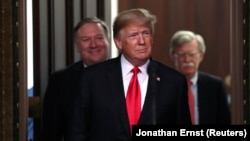What is the Trump administration trying to achieve in Iran? More than two-and-a-half years after candidate Trump made Iran a centerpiece of his foreign-policy platform on the presidential campaign trail, and over a year after Iran emerged as one of his administration’s core international priorities, there is still a great deal of confusion about what, exactly, the White House is seeking to accomplish vis-a-vis the Islamic Republic.
The confusion is understandable, because so far the Administration appears to have embraced at least three separate approaches.
The first, articulated by Secretary of State Mike Pompeo in his May 2018 speech before the Heritage Foundation in Washington, DC, envisions Iranian acquiescence to a range of invasive demands – from the withdrawal of its troops from Syria to permitting greater inspections of the country’s nuclear facilities and ballistic missile arsenal – as a prerequisite for diplomatic normalization between Washington and Tehran.
These demands, Pompeo has made clear, do not amount to a call for regime change, but rather simply an insistence that Iran behave as a “normal country” and responsible international stakeholder. What isn’t clear, however, is whether Iran’s regime can do so and still maintain its ideological cohesion. The responses from Iran’s leaders to date suggest that they don’t think it can.
By contrast, President Trump has gravitated toward a more transactional approach. He has repeatedly signaled his willingness to negotiate a new framework accord with the Iranian regime – as long as that deal is more beneficial to America and its international partners then the 2015 nuclear deal crafted by his predecessor, which he believes was “disastrous.”
Finally, the preferred outcome of some of the administration – most prominently National Security Advisor John Bolton – involves applying broad ranging economic and political pressure on the Iranian regime, even to the point that it precipitates some sort of “regime collapse.” Far less attention, however, has been paid by the Administration to just what form that collapse, if it does occur, might take. Here, Iran faces a number of potential alternative futures, from a military takeover (like in Egypt) to national fragmentation (like in Libya) to protracted regime decline (like in Venezuela), each of which would have a very different outcome for the country and its people.
At first blush, these strategies seem contradictory, even if the tactics they use to achieve them (including a massive re-imposition of economic sanctions) are the same. But a closer examination suggests that the way the White House thinks about Iran is more open-ended – and flexible.
Here, it’s helpful to look at an official summary of the administration’s approach to Iran recently released by the White House. Authored by Victoria Coates, the National Security Council’s Senior Director for the Middle East, it lays out the clearest rationale to date for the steps that the Administration has taken so far against the Islamic Republic.
The United States, Coates lays out, sees Iran as a malign regional actor, whose current path of destructive regional activity and expansion has been greatly empowered by the dividends it received from the 2015 nuclear deal. As a result, the Administration’s core objective is to foster a “systemic change in the Islamic Republic’s hostile and destabilizing actions.” These include curtailing “all paths” by which Iran might be able to acquire a nuclear weapon, and preventing the regime from “exporting terrorism” throughout the region or beyond.
Left unanswered in this discussion is whether the White House has embraced the idea of regime change within Iran, as some have contended. But the silence is itself an answer.
Simply put, to the degree that the Trump administration believes it possible to change the Islamic Republic’s behavior and moderate the global threat it poses, it will stop short of advocating regime change. If it becomes convinced that real change is impossible from the current regime in Tehran, however, the Administration is prepared to embrace another. And, as President Trump and his team see it, the decision is entirely Iran’s to make.








